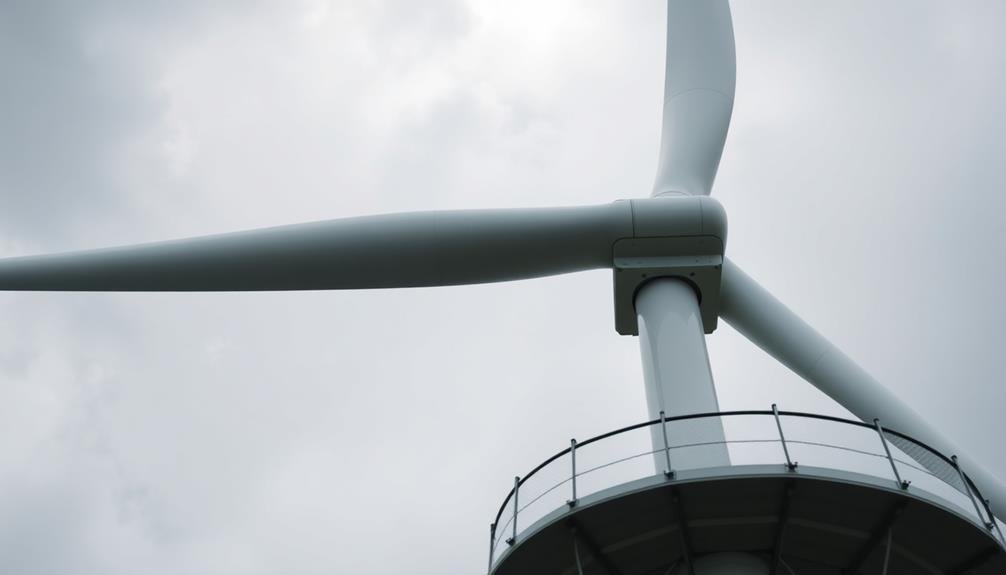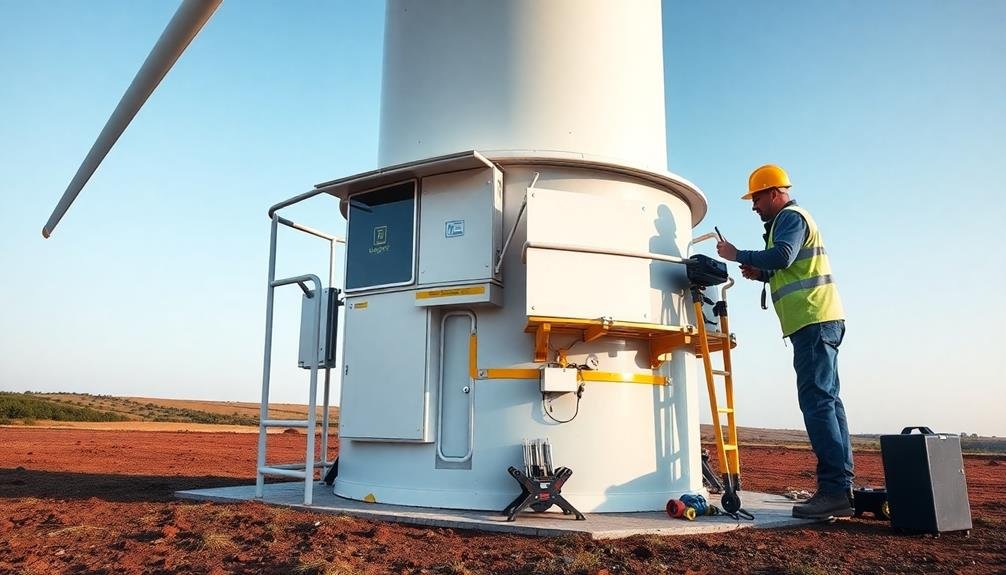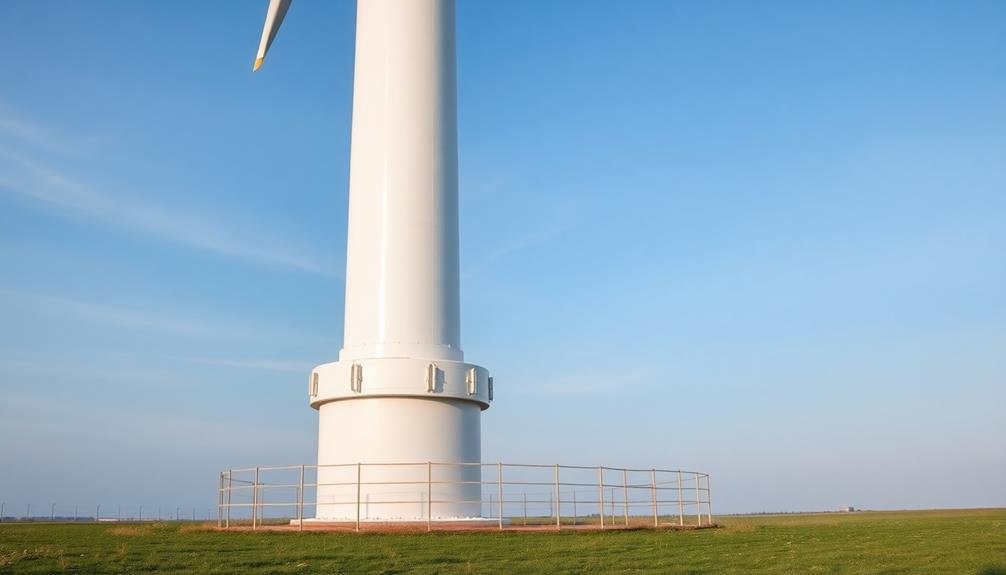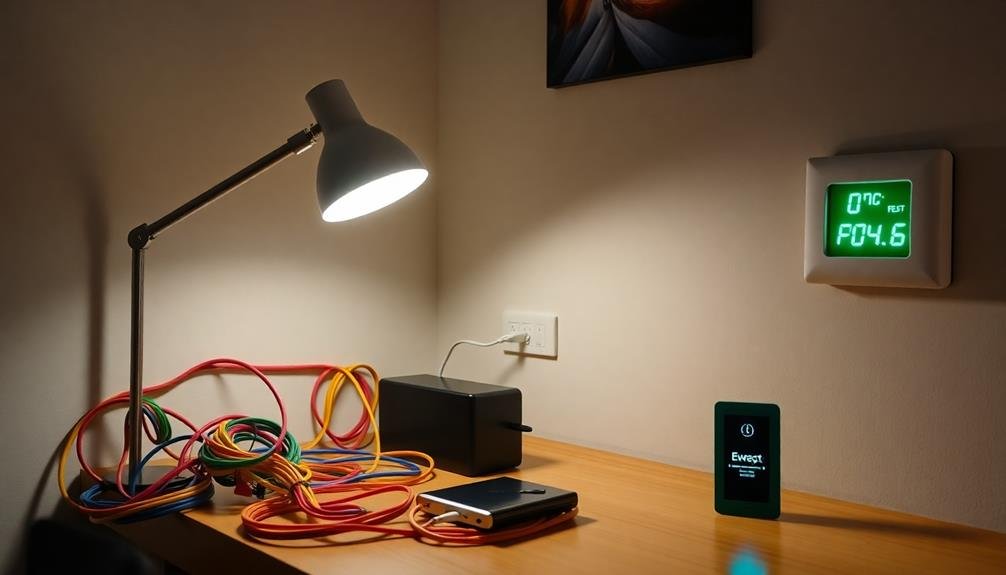Vertical axis wind turbines boast three key safety features that make them stand out. First, their low-speed rotation design, operating at just 30-60 RPM, reduces hazards and minimizes wildlife collisions. Second, they incorporate self-regulating overspeed protection, using passive stall regulation to prevent damage from excessive speeds. Third, these turbines offer compact ground-level maintenance, allowing for easy access to critical components without specialized equipment. This design not only cuts down on maintenance time and costs but also enhances safety during inspections and repairs. These features combine to create a safer, more efficient turbine system that's worth exploring further.
Low-Speed Rotation Design

Safety first: Vertical axis turbines are engineered with a low-speed rotation design, greatly reducing potential hazards. You'll find that these turbines typically operate at speeds between 30 to 60 rotations per minute (RPM), much slower than their horizontal-axis counterparts. This deliberate design choice minimizes the risk of mechanical failure and blade detachment, enhancing overall safety.
The low-speed rotation also addresses concerns about wildlife protection. Birds and bats are less likely to collide with slower-moving blades, markedly reducing the environmental impact. You'll appreciate that this feature makes vertical axis turbines more suitable for urban and residential areas, where safety is paramount.
Moreover, the slower rotation produces less noise pollution. You won't have to worry about the constant whooshing sound often associated with faster-spinning turbines. This quieter operation contributes to a more pleasant living environment and reduces potential health issues related to noise exposure.
The low-speed design also translates to lower maintenance requirements and increased longevity. You'll benefit from reduced wear and tear on components, leading to fewer replacements and a lower risk of mechanical failures that could compromise safety.
Self-Regulating Overspeed Protection
A crucial safety feature in vertical axis turbines is their self-regulating overspeed protection mechanism. This ingenious system helps prevent damage and potential accidents caused by excessive rotational speeds during high wind conditions.
Unlike horizontal axis turbines that require complex pitch control systems, vertical axis turbines often utilize passive stall regulation. As wind speeds increase, the blades of a vertical axis turbine begin to stall, reducing their efficiency and naturally limiting the rotor's speed. This phenomenon occurs due to the changing angle of attack as the blades rotate, creating areas of turbulence that decrease lift.
You'll find that this self-regulating feature is particularly effective in Darrieus-type turbines. In addition to passive stall, some vertical axis turbines incorporate mechanical brakes or aerodynamic spoilers that activate at predetermined speeds. These systems provide an extra layer of protection against overspeed events.
Compact Ground-Level Maintenance

While self-regulating overspeed protection guarantees operational safety, another key advantage of vertical axis turbines lies in their compact ground-level maintenance capabilities. You'll find that these turbines are designed with accessibility in mind, allowing you to perform routine checks and repairs without the need for specialized equipment or risky elevated work.
Unlike traditional horizontal axis turbines, vertical axis models keep critical components close to the ground. This design feature considerably reduces maintenance time and costs while enhancing worker safety. You'll appreciate the ease with which you can inspect, repair, or replace parts such as generators, gearboxes, and control systems.
Here's a comparison of maintenance aspects between vertical and horizontal axis turbines:
| Aspect | Vertical Axis | Horizontal Axis |
|---|---|---|
| Height | Ground level | Elevated |
| Access | Easy | Challenging |
| Equipment | Minimal | Specialized |
| Safety risk | Low | High |
| Downtime | Reduced | Extended |
You'll notice that vertical axis turbines offer a more streamlined maintenance process. This efficiency not only saves time and money but also guarantees that your turbine spends more time generating power and less time undergoing repairs or inspections.
Frequently Asked Questions
How Do Vertical Axis Turbines Compare to Horizontal Axis Turbines in Terms of Efficiency?
You'll find that horizontal axis turbines are generally more efficient than vertical axis turbines. They can capture more wind energy and convert it to power more effectively. However, vertical axis turbines have advantages in certain situations.
What Are the Noise Levels Produced by Vertical Axis Turbines?
You'll find vertical axis turbines are generally quieter than horizontal ones. They produce less noise due to their lower blade tip speeds. However, noise levels can vary depending on the specific design and operating conditions.
How Do Vertical Axis Turbines Impact Local Wildlife, Especially Birds?
You'll find that vertical axis turbines have less impact on birds compared to horizontal ones. They're slower and more visible, reducing collision risks. However, they can still affect local habitats and migration patterns, so environmental assessments are essential.
What Is the Typical Lifespan of a Vertical Axis Turbine?
You'll find that vertical axis turbines typically last 20-25 years. However, with proper maintenance and regular component replacements, you can extend their lifespan to 30 years or more. It's important to take into account site-specific factors too.
Can Vertical Axis Turbines Be Used for Both Onshore and Offshore Wind Farms?
Yes, you can use vertical axis turbines for both onshore and offshore wind farms. They're versatile and adaptable to various environments. You'll find them in urban settings, coastal areas, and even floating platforms for offshore applications.
In Summary
You've seen how vertical axis turbines prioritize safety through their thoughtful design. With low-speed rotation, you'll worry less about potential hazards. You can trust in the self-regulating overspeed protection to keep the turbine in check during high winds. And when maintenance is needed, you'll appreciate the convenience of ground-level access. By choosing vertical axis turbines, you're opting for a safer, more manageable renewable energy solution that doesn't compromise on efficiency or performance.





Leave a Reply